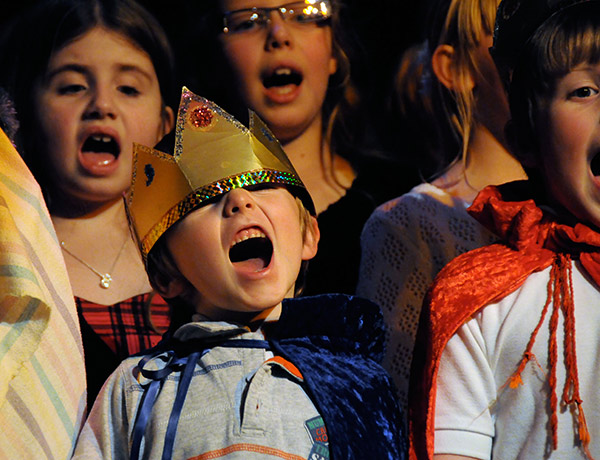Subtotal: $
Checkout
This article was originally published on December 22, 2015.
“And it came to pass in those days, that there went out a decree from Caesar Augustus that all the world should be taxed…”
The lights at the front of the church dim, and the magi enter, singing “We Three Kings,” but in their North Louisiana accents the opening line comes out something like “Way thray kangs,” as the church pianist tries desperately to cover up their lack of harmony. One of the wise men is a college football player home for the holidays recruited at the last minute to replace a missing actor. Wearing a purple turban, costume jewelry, and a huge swathe of leopard print fabric, he lumbers down the aisle, dwarfing the rest of the cast. Before the Holy Family arrives, the child playing the donkey drops his costume head (a motorcycle helmet with felt ears attached) at the back of the church, and it rolls down the aisle. Preparing for the arrival of Joseph, Mary, and Jesus, the congregation is greeted instead by a detached donkey head and its owner chasing after it.
Like countless communities staging Nativity plays this December, my hometown in Northeast Louisiana dramatizes the events surrounding Christ’s birth from Matthew and Luke during the Christmas season. And like many community productions, ours is not without incident, as the events above illustrate. Despite occasional mishaps, or maybe because of them, our local Nativity play is one of my favorite holiday observances.

Dave Donaldson / Alamy Stock Photo
This venerable tradition is older than one might guess. As the Cambridge Companion to Medieval English Theatre explains, the local Nativity play has its roots in the Middle Ages. According to Alexandra F. Johnston, the church used drama in the late fourteenth century so believers could experience more fully episodes from the life of Christ. The Adoration of the Shepherds and the Magi was one such episode dramatized in local parishes.
Today the local Nativity play still retains medieval features that have contributed to its longevity. For example, both contemporary and medieval versions show regional idiosyncrasies. In the Second Shepherds’ Play, a medieval play that ends with the shepherds’ encounter with Christ, the title characters react to the news of his birth like medieval Englishmen: rather than striving for historical authenticity, the Second Shepherds’ Play shows its origins with its Yorkshire dialects and references to local villages, similar to our North Louisiana productions with their distinct accents and inventive costumes.
With expressions of regional personality, Nativity plays fostered community identity in earlier times just as they do today. Johnston notes that medieval communities celebrated “their sense of themselves” through such dramas. Likewise, churchgoers across the country will enjoy the local character on display in Nativity plays this Christmas. They will see community members enact the various roles, hear their own voices recite verses from Matthew and Luke, and admire the sets and costumes created by friends and neighbors.
Contemporary Nativity plays have their share of chaos and sentimentality, but the doting relatives, botched lines, and wardrobe malfunctions often lead to merriment, another very old feature of Christmas celebrations. I am reminded of the “carefree mirth” of the Christmastide revels at King Arthur’s court in Sir Gawain and the Green Knight, which surely reflects something of the medieval festivities outside of the poem: “For the feast was in force full fifteen days, / With all the meat and the mirth that men could devise, / Such gaiety and glee, glorious to hear, / Brave din by day, dancing by night.”
At their best, however, Nativity plays don’t just convey regional identity and merriment. Like their medieval predecessors, they allow believers to experience events in the life of Christ with immediacy. In my experience, what is possible in the presence of a neighbor’s son as Joseph, the youth group leader’s daughter as Mary, and someone’s grandchild from out of town as Jesus is the recognition of the powerful frailty and the humility of God incarnate. The Nativity play endures as a celebration of God with us: “…for, behold, I bring you good tidings of great joy, which shall be to all people. For unto you is born this day in the city of David a Saviour, which is Christ the Lord.”
Already a subscriber? Sign in
Try 3 months of unlimited access. Start your FREE TRIAL today. Cancel anytime.







Kenny Hardin
Your article made me laugh!! I love the nativity and the messiness of not having reservations in Bethlehem. Mary, So pregnant and riding on a donkey. Joseph, still scratching his head regarding his betrothed’s pregnancy. Our church, like yours tries to depict this blessed event with folks of all shapes, ages, and defects. It always brings a smile and draws us closer, just like the shepherds who got the 1st invite to the manger.
Gary Spangler
What a wonderful contextualization of The Nativity in traditions past and present.